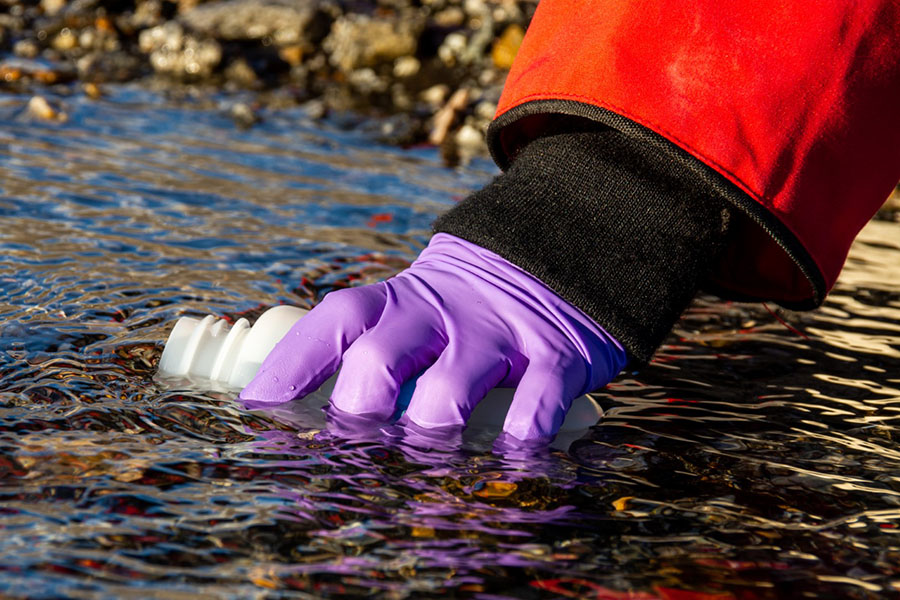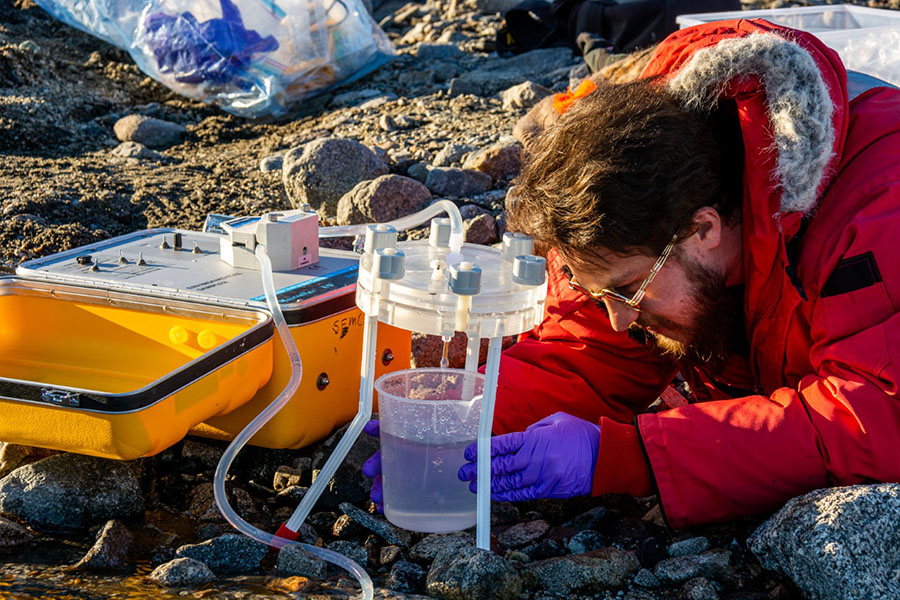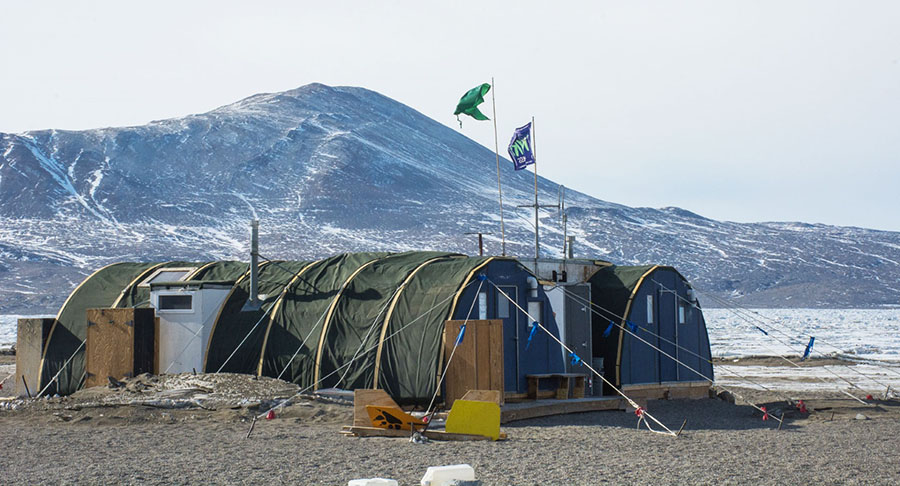Pumping IronHow an Increase in Aqueous Iron Destined for the Southern Ocean Could Change the WorldPosted May 26, 2020
Cold, hard iron is on the move. 
Photo Credit: Mike Lucibella
Water flowing from melting glaciers flows over the sandy soils of the McMurdo Dry Valleys, collecting iron particles before flowing into the nearby sea.
Particles of the ferrous metal are trickling into Antarctica's oceans, and marine algae are gobbling it up. Leached out of the sandy landscape of the McMurdo Dry Valleys and carried by the waters of melting glaciers, it's nourishment for phytoplankton, the microscopic algae that live in the Southern Ocean. "It's a micronutrient," said Berry Lyons, a geochemist at The Ohio State University and principal investigator on the project. "It's needed for biological growth and production." With the temperature of the planet on the rise and glacial melt accelerating, this iron influx is likely to increase as well. "As the climate warms and there’s more runoff from the glaciers in Antarctica, this source of iron to the Southern Ocean could become more important than it probably is today," Lyons said. Scientists want to know how big this potential flood of iron might be, and if it could lead to a burst of phytoplankton growth across the Southern Ocean large enough to affect the climate. "They consume carbon and that carbon primarily comes from the dissolution of [carbon dioxide] in the atmosphere into the ocean," Lyons said. "If you were to increase the iron concentration in places like the Southern Ocean, you could increase primary production and hopefully draw down CO2." The project is supported by the National Science Foundation, which manages the U.S. Antarctic Program. 
Photo Credit: Mike Lucibella
In the Miers Valley, Melisa Diaz collects a water sample from a stream of glacial runoff.
Plankton FoodIron is hard to come by in the seas surrounding Antarctica. "The Southern Ocean is iron-limited, or iron deficient, which means though there's plenty of nitrogen and phosphorus, there's insufficient iron concentration for phytoplankton growth," said Chris Gardner, a research scientist and co-principal investigator at The Ohio State University. This iron is coming out of the ground itself. The rocks and soils of the McMurdo Dry Valleys have a high iron content that erodes out as liquid water flows over the landscape. However, relatively little actually reaches the oceans as streams are few and far between, and they only flow for a few weeks of the year. "Iron is being chemically weathered from that geological material as the water flows through it," Lyons said. "We think that the primary source of iron is from the interaction between the water and the mineral particles in the streams." Scientists think that right now, streams carrying eroded iron make at most a modest contribution to the iron in the Southern Ocean. More than 98 percent of Antarctica is covered in ice, so there are only a few areas of open soil for streams to flow and collect iron from the soil. Even in places like the McMurdo Dry Valleys that are ice-free, it's only warm enough for liquid water to flow for a few weeks a year. "It's a fairly small fraction overall, there are other sources of course. Icebergs are the biggest source," Gardner said. "You see these dirty icebergs full of dust and stuff, and as they go out and melt and all of that it enters the ocean, others have actually seen phytoplankton blooms following the path of an iceberg." However, as the continent warms, that amount could change and have big impacts on the ecosystem of the Southern Ocean. If the iron that reaches the sea is a kind that microorganisms can metabolize, it could spur the growth of phytoplankton and potentially even affect the climate. 
Photo Credit: Mike Lucibella
To avoid iron contamination, the team had to wear protective equipment when taking samples and spend a lot of time cleaning their equipment before traveling out to the field.
"Phytoplankton are photosynthesizers that use dissolved carbon dioxide from the atmosphere and we're interested in the possibility of this glacial meltwater to fertilize phytoplankton," Gardner said. "As the Earth continues to warm and concentration of CO2 goes up in the atmosphere, glaciers melt back creating more glacial meltwater. If there’s an increased volume of glacial meltwater, there's potentially an increased area of ice-free areas where the iron would be weathered from rocks… If that iron is in a form that could potentially fertilize phytoplankton in the Southern Ocean, that could essentially create a phytoplankton bloom that could draw CO2 down out of the atmosphere." But it's hard to make solid predictions with the meager data available. Scientists aren't sure how much iron is reaching the seas or even what kind it is. "We don't really have a good feel for how much glacial meltwater is draining," Gardner said. "We don't have good stream-flow numbers for that, we can’t really calculate it." To get a better idea of how much and what kind of iron is entering the oceans, Gardner and his field team set out for Antarctica to go prospecting. Cold Iron BoundNot all iron is the same. How useful it is for phytoplankton depends essentially on how tightly its atoms are bound to the other atoms of whatever chemical compound it's in. The researchers are looking at the two main states of the element; iron(II) which shares two of its electrons with the compound it's bonded with, and iron(III) which shares three. That distinction makes a big difference on how easily microorganisms can extract it and use it themselves. "Rocks contain both forms of iron. Iron(II), which is the reduced form, is potentially usable by phytoplankton and other biology," Gardner said. "As soon as it hits the atmosphere it tends to oxidize, and it creates what is essentially rust, Iron(III) hydroxides… it's not as readily bioavailable unless it's present as very small nanoparticles in a certain mineral called ferrihydrite." The team is looking to see what kind of iron is reaching the oceans. If they find iron(II) or ferrihydrite predominantly making it out to sea, it has the potential to drive the growth of phytoplankton. However, if the more inert forms of iron(III) make it out, then it's unlikely to stimulate big phytoplankton blooms. 
Photo Credit: Mike Lucibella
Chris Gardner takes a water sample from a stream’s hyporheic zone, the damp soil around a stream where water flows and picks up iron particles.
"That's one of the issues that not only our group is interested in, but there are a whole bunch of scientists around the world working on trying to understand the transport of iron from glaciers or glacier melt and how effective it might be – even if there's a lot of it – in increasing primary production, particularly further out in the southern ocean," Lyons said. For about three weeks, the team stayed at the New Harbor field camp at the mouth of the McMurdo Dry valleys to collect and process samples from the nearby streams. "It's right next to Wales Stream which is a stream that discharges directly into the Southern Ocean and it's a short walk to Commonwealth Stream which is another one," Gardner said. In addition, they also visited Miers Valley to collect samples from the stream that flows through there. "We decided to focus on the streams that are actually transporting iron into the coastal zone in the McMurdo Dry Valleys," Lyons said. In addition to collecting water straight from the flowing streams, the team also took samples from the dampened stream banks called the hyporheic zones. Though not as swift as on the surface, water flows through these areas as well, and are likely where much of the iron erosion is actually taking place. "There's a lot of different samples from various geographic locations and experiments that we did that are mainly going to be analyzed for iron," Lyons said. 
Photo Credit: Mike Lucibella
Adolfo Calero carefully monitors a device collecting water samples from a stream in the Miers Valley.
A Clean SweepCollecting these water samples required special attention. The iron flowing through the streams is sparse, only a few parts per billion. This meant that the team had to take extraordinary steps to keep their samples free from outside contamination. "This project is trying to take something that would normally happen in some ultra-clean lab back at Ohio State or wherever else, and trying to recreate that in the field in the best way that we can," said Melisa Diaz, a PhD student and geochemist at The Ohio State University. The first step, even before the team left for Antarctica, was to make sure everything they brought into the field was completely clean. "We spent a lot of time at Ohio State, before we got here, preparing all of our equipment," Diaz said. "All of the bottles have to be washed in a series of acid and deionized water rinses and we're trying to keep everything clean." Much of what they brought for the field was double plastic bagged and taped to keep contamination out. Even after the team arrived at McMurdo Station, the washing of their equipment continued. "A lot of bottle washing," said Adolfo Calero, a graduate student at the Ohio State University. "I've had to wash bottles at least five or six times with [deionized] water just to make sure everything gets out." 
Photo Credit: Mike Lucibella
The team spent most of their time in the field at the New Harbor camp where they could sample the nearby Wales and Commonwealth streams that feed directly into McMurdo Sound.
Keeping their equipment clean was a constant struggle. They covered nearly every inch of their lab at the New Harbor camp with plastic sheeting to keep out dust and iron particulates that may have gotten embedded in the lab benches. Out in the field on a cold day, the team couldn't keep warm with air-activated chemical hand warmers because of the iron in them. However, the biggest challenge was protecting against windblown dust. "That dust is full of iron," Diaz said. "We have to somehow find a way to keep the iron that's blowing around in the windiest place on Earth, out of our lab and out of our samples… [It's] just kind of funny trying to do these really really clean lab procedures in a very dirty environment." They had to set up their own clean lab in the field because for many of their tests, time was of the essence. Iron(II) starts to oxidize quickly once it's exposed to air, so they needed to conduct their tests close to the source. For the rest of the analysis, the team shipped hundreds of water samples to The Ohio State University and to their colleague Peter Croot at the National University of Ireland, Galway which they'll continue to examine over the next several months. "We have a bunch of analytical chemistry to do in the lab and our university," Lyons said. "It's a matter of doing all the chemical analyses and then we'll sit down and try to put the story together." NSF-funded research in this story: W. Berry Lyons and Christopher Gardner, The Ohio State University, Award No. 1841228. |



For USAP Participants |
For The Public |
For Researchers and EducatorsContact UsU.S. National Science FoundationOffice of Polar Programs Geosciences Directorate 2415 Eisenhower Avenue, Suite W7100 Alexandria, VA 22314 Sign up for the NSF Office of Polar Programs newsletter and events. Feedback Form |


